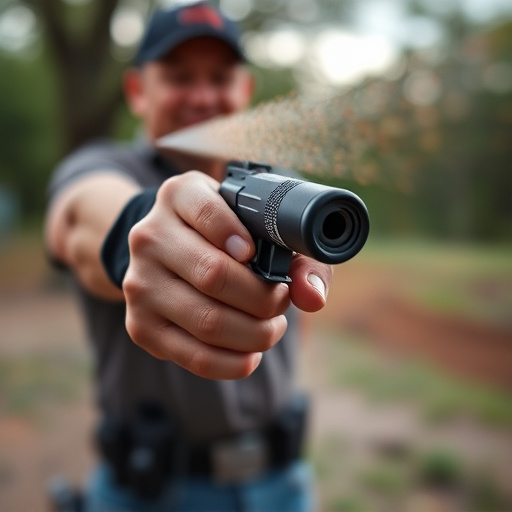Pepper Spray Training for Beginners: Essential Skills for Safe Crowd Control
Beginners in pepper spray training learn to deploy this powerful crowd control tool safely and responsibly. The curriculum covers understanding spray mechanics, active ingredients (like oleoresin capsicum), types, and optimal use distances. Advanced training emphasizes safety measures, de-escalation strategies, and handling techniques crucial for real-world scenarios, ensuring effective yet controlled usage in high-pressure situations. Proper training maximizes pepper spray's effectiveness while minimizing risks, fostering its responsible use by law enforcement and security personnel.
In today’s diverse and dynamic public gatherings, understanding crowd control methods like pepper spray is crucial. This article serves as a comprehensive guide for beginners on pepper spray training, offering insights into its effectiveness as a crowd control tool of choice. We’ll explore the mechanics of pepper spray, debunk common misconceptions, and delve into safety measures during training, empowering individuals to navigate such scenarios with confidence and proficiency.
- Understanding Pepper Spray: A Beginner's Guide
- Why Pepper Spray is a Crowd Control Tool of Choice
- Effective Use and Safety Measures During Training
- Debunking Common Misconceptions About Pepper Spray
Understanding Pepper Spray: A Beginner's Guide
Pepper spray, officially known as oleoresin capsicum (OC) spray, is a powerful tool used by law enforcement and security personnel for crowd control and self-defense. It’s not just a quick-fix solution; it requires understanding its effects and proper usage to ensure safety and effectiveness. Pepper spray training for beginners is essential to grasp the basics of this chemical agent.
When deployed, pepper spray creates a burning sensation in the eyes, nose, and respiratory system, temporarily disabling the target. This disruption allows officers to gain control over potentially dangerous situations, including large crowds or individuals who pose a threat. Beginners should learn about different types of pepper spray, their strengths, and how they work on the body’s neural pathways. Proper training also involves understanding safe handling practices, deployment techniques, and decontamination methods after use.
Why Pepper Spray is a Crowd Control Tool of Choice
Pepper spray, also known as oleoresin capsicum (OC) spray, has become a crowd control tool of choice for law enforcement agencies worldwide due to its effectiveness and relatively non-lethal nature. Its primary active ingredient, capsaicin, stimulates the nerve endings in the eyes, nose, and respiratory system, causing temporary disorientation and pain, thereby enabling officers to subdue or disperse agitated individuals or large crowds quickly and efficiently.
The widespread adoption of pepper spray as a crowd control measure is underpinned by rigorous Pepper Spray Training for Beginners. This training equips law enforcement officers with the necessary skills to handle pepper spray safely and responsibly. It covers topics such as spray application techniques, understanding different types of pepper spray, de-escalation strategies, and proper response protocols when faced with resistant individuals or large gatherings. Such training ensures that officers not only know how to deploy pepper spray effectively but also understand its limitations and potential risks, thereby facilitating its use in a controlled and proportionate manner.
Effective Use and Safety Measures During Training
Pepper spray, a powerful crowd control tool, requires meticulous training for beginners to ensure its effective and safe use. The initial stages of pepper spray training focus on understanding the fundamentals: its mechanism, how it works, and the different types available. Officers learn about the active ingredients, their strengths, and the distance at which they’re most effective. This knowledge is vital for making informed decisions in high-pressure situations.
Safety measures take center stage during advanced training. Beginners are taught proper handling techniques to prevent accidental discharges. They also learn about de-escalation strategies, crucial for diffusing tense crowds without resorting to pepper spray. Training includes scenarios that mimic real-world situations, allowing officers to gain practical experience while ensuring their safety and the safety of those around them.
Debunking Common Misconceptions About Pepper Spray
Pepper spray, a powerful crowd control tool, often invites misconceptions and fears. A common misunderstanding is that it’s indiscriminate and harmful to everyone. In reality, pepper spray is designed to incapacitate individuals temporarily, affecting their eyes, sinuses, and respiratory system. It does not cause permanent harm and is aimed at de-escalating situations, giving law enforcement time to control crowds or arrest individuals.
Another misconception is that anyone can use pepper spray effectively without proper training. However, like any tool used in high-pressure situations, pepper spray requires training for beginners. This includes understanding its range, activation mechanisms, and safe handling practices to ensure it’s used appropriately and responsibly, maximizing its effectiveness while minimizing risks.
Pepper spray has established itself as a preferred crowd control tool, as evidenced by its widespread adoption by law enforcement agencies. The article has explored various facets of this powerful agent, including its mechanics, benefits, and safety protocols. For those new to pepper spray, understanding its proper use and the associated safety measures is paramount. Engaging in comprehensive training, such as our guide for beginners, ensures that individuals can effectively deploy pepper spray while minimizing risks and maximizing its impact as a last resort tool during crowd control scenarios.
